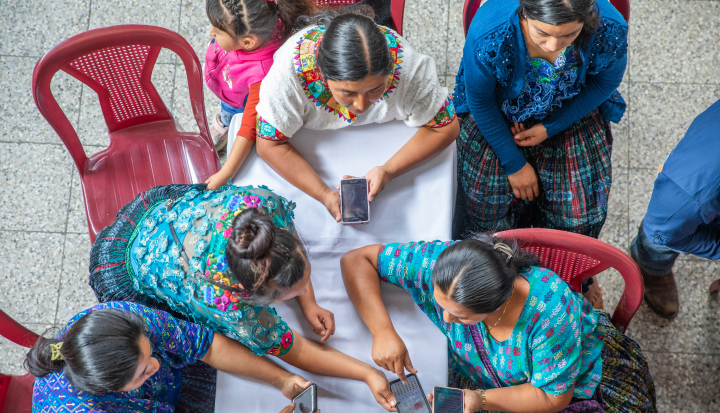All over the world, 3.6 billion people are climate vulnerablemost of them are women. As the climate crisis intensifies, this is no longer an issue if but when these communities will face a climate emergency.
last year, 223.7 USD an amount comparable to billion was given in aid globally annual GDP New Zealand, Portugal or Qatar. About 99% of traditional humanitarian aid is given retroactively – only after the worst effects of disasters have been experienced. However, thanks to the advancement of science and technology more than half of all humanitarian crises predictable (and 20% highly predictable).
What is the Expected Action?
Anticipatory action involves taking initial steps to mitigate the worst effects of disasters before they occur. Using early warning systems, artificial intelligence, weather data and pre-positioned resources, organizations can distribute cash and vital resources days or weeks before a flood, hurricane or drought strikes, for example.
Anticipatory action at Mercy Corps has proven transformative. Some of our latest pilot projects have demonstrated the impact of proactive measures across different regions and contexts:
Using Blockchain for Pastoralists Affected by Drought in the Horn of Africa
Mercy Corps Ventures, the impact investing arm of Mercy Corps, is experimenting blockchain-based pending action Helping pastoralists affected by drought in the Horn of Africa. Pastoralism is a way of life 50 million People in sub-Saharan Africa depend on livestock for income and subsistence. Using blockchain, Mercy Corps has facilitated access to digital wallets, enabling pastoralists to receive early financial aid in anticipation of worsening drought conditions. The pilot resulted in a 75% reduction in operational costs and a 90% reduction in time to deliver donations, helping pastoralists protect their livestock and livelihoods before the drought intensified.
Remittances for pending activity in Central America
The flow of remittances—remittances from family and friends abroad—is one way communities can receive funds faster before a disaster. In 2023, remittances to low- and middle-income countries will reach $656 billion. According to the World Bank – Three times the number of Official Development Assistance. During the 2022-2023 hurricane seasons, Mercy Corps tested Remittances for the Expected Action model in Central Americathis allowed families to send remittances early based on hurricane forecasts, equipping recipients with funds to prepare and protect their homes and livelihoods ahead of the storm. The program has shown that early action can prevent damage and reduce stress on emergency response systems.
Cash Aid for Flood Resilience in Nepal
In Nepal, Mercy Corps launched an anticipatory action pilot to support 373 flood-prone families in 14 communities. When early warning systems detected increased flood risks, Mercy Corps distributed cash through ATM cards to enable families to invest in flood prevention measures. 79% of households were able to meet their basic needs during the floods, and 72% of recipients reported that cash assistance arrived in time to meet their needs, helping them prioritize food, water or shelter improvements.
Business Case for Anticipated Action
A growing body of evidence shows that anticipatory action not only saves lives and livelihoods, but also helps protect and improve human dignity. value for money. For example, studies show that $1 invested in early disaster mitigation can save $6 in losses.
Scaling up and strengthening anticipatory measures should be a top priority for the private sector, as it enables more effective, cost-effective risk reduction for people, businesses and economies. Here are some opportunities for businesses to increase their expected traffic:
1. Invest in Early Warning Systems and Data Infrastructure
Many businesses have the data, technology and networks needed to strengthen their early warning systems. By investing in advanced climate data collection and analytics, companies can support real-time threat forecasts that lead to timely humanitarian interventions. For example, insurance companies, technology companies, and data providers can collaborate to improve forecast accuracy and availability.
2. Support for pre-disaster financing mechanisms
Insurers and financial institutions, for example, can partner with NGOs to create financial instruments that unlock funds for communities before disasters strike. A commitment to crisis financing at the local level can facilitate faster recovery, benefiting businesses that rely on stable markets and resilient communities.
3. Advocate for Policy Change
The private sector can advocate for national policies that favor anticipatory measures, such as budget allocations for pre-disaster planning or climate resilience in public infrastructure projects. When businesses join these advocacy efforts, they help create an environment conducive to the expected action.
4. Increase Resilience in Supply Chains
By embedding sustainability into their supply chains, businesses can further support anticipated actions. This could include working with local suppliers to develop climate-resilient strategies, pre-positioning restoration resources in high-risk areas, or incorporating predictive climate models into decision-making processes. By planning ahead, companies not only protect their own operations, but also contribute to the broader sustainability of the communities they serve.
Given the rising costs of increasingly frequent and severe climate-related disasters, it is important to scale up investments in anticipatory measures. COP29 – the “financial COP” – is a critical moment. As global leaders gather to discuss climate justice, we call on business leaders to invest in proactive action and adopt proactive measures within their climate strategies. Now is the time to act – before the next flood, drought or hurricane hits. Join us in harnessing the power of business for a world where climate sustainability is possible for all.

